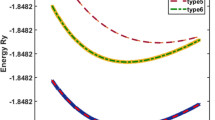Abstract
Temporal evolution of electronegativity and hardness associated with a collision process between a Be atom and a proton has been studied within a quantum fluid density functional framework. In the presence of a third collisional partner to take away excess energy, this collision may lead to a chemical reaction producing a BeH+ molecule. For comparisonab initio SCF level calculation (with 6–31G** basis set) on BeH+ molecule with different geometries have been performed. Electronegativity equalization and maximum hardness principles are analyzed.
Similar content being viewed by others
References
L Pauling,The nature of the chemical bond (Cornell Univ. Press, Ithaca, New York, 1960) p. 88
R P Iczkowski and J L Margrave,J. Am. Chem. Soc. 83, 3547 (1961)
R G Parr, R A Donnelly, M Levy and W E Palke,J. Chem. Phys. 68, 3801 (1978)
K D Sen and C K Jørgensen eds.,Electronegativity, structure and bonding, (Springer, Heidelberg, 1987) Vol. 66
R G Pearson,J. Am. Chem. Soc. 85, 3533 (1963)
R G Parr and R G Pearson,J. Am. Chem. Soc. 105, 7512 (1983)
R G Parr and W Yang,Density functional theory of atoms and molecules (Oxford University Press, New York, 1989)
K D Sen and D M P Mingos eds.,Chemical hardness, structure and bonding, (Springer-Verlag, Berlin, 1992) Vol. 80
P K Chattaraj and R G Parr in reference 8
P K Chattaraj,J. Indian Chem. Soc. 69, 173 (1992)
R G Pearson,Proc. Natl. Acad. Sci. USA,83, 8440 (1986)
R T Sanderson,Science 114, 670 (1951);116, 41 (1952);121, 207 (1955)
R T Sanderson,J. Chem. Educ. 29, 539 (1952);31, 238 (1954)
R A Donnelly and R G Parr,J. Chem. Phys. 69, 4431 (1978)
P Politzer and H Weinstein,J. Chem. Phys. 71, 4218 (1979)
R G Parr and L Bartolotti,J. Am. Chem. Soc. 104, 3801 (1982)
P K Chattaraj, H Lee and R G Parr,J. Am. Chem. Soc. 113, 1855 (1991)
R G Pearson,J. Chem. Educ. 64, 561 (1987)
R G Parr and P K Chattaraj,J. Am. Chem. Soc. 113, 1854 (1991)
R G Parr and J L Gázquez,J. Phys. Chem. 97, 3939 (1993)
P K Chattaraj and S Nath,Int. J. Quantum Chem. 49, 705 (1994)
S Nath, P K Nandi, A B Sannigrahi and P K Chattaraj,J. Mol. Struct. 279, 207 (1993)
R G Pearson and W E Palke,J. Phys. Chem. 96, 3283 (1992)
D Datta,Inorg. Chem. 31, 2797 (1992)
D Datta,J. Phys. Chem. 96, 2409 (1992)
P K Chattaraj and P v R Schleyer,J. Am. Chem. Soc. 116, 1067 (1994)
M Galván, A D Pino and J D Joannopoulos,Phys. Rev. Lett. 70, 21 (1993)
A D Pino, M Galván, T A Arias and J D Joannopoulos,J. Chem. Phys. 98, 1606 (1993)
P K Chattaraj, S Nath and A B Sannigrahi,Chem. Phys. Lett. 212, 223 (1993)
P K Chattaraj, S Nath and A B Sannigrahi,J. Phys. Chem. 98, 9143 (1994)
P K Chattaraj, and S Nath,Indian J. Chem. A33, 842 (1994)
J L Gázquez, A Martínez and F Méndez,J. Phys. Chem. 97, 4059 (1993)
S Nath, A B Sannigrahi and P K Chattaraj,J. Mol. Struct. 306, 87 (1994)
S Nath, A B Sannigrahi and P K Chattaraj,J. Mol. Struct. 309, 65 (1994)
P K Chattaraj and S Nath,Proc. Indian Acad. Sci. (Chem. Sci.) 106, 229 (1994)
P K Chattaraj and S Nath,Chem. Phys. Lett. 217, 342 (1994)
S M Read and J T Vanderslice,J. Chem. Phys. 37, 205 (1962)
K E Banyard and G K Taylor,J. Phys. B8, L137 (1975)
K P Huber and G Herzberg,Molecular spectra and molecular structure, Constants of diatomic molecules (Van Nostrand, New York, 1979) Vol. IV, p. 81
B M Deb and P K Chattaraj,Phys. Rev. A39, 1696 (1989)
B M Deb and P K Chattaraj,Chem. Phys. Lett. 148, 550 (1988)
B M Deb, P K Chattaraj and S Mishra,Phys. Rev. A43, 1248 (1991)
P K Chattaraj,Int. J. Quantum Chem. 41, 845 (1992)
B M Deb and P K Chattaraj, inSolitons: Introduction and application, edited by M Lakshmann (Springer, Berlin, 1988) pp. 11–25
P K Chattaraj inSymmetries and singularity structures: Integrability and chaos in nonlinear dynamical systems, edited by M Lakshmann and M Daniel (Springer-Verlag, Berlin 1990) pp. 172–182
W J Hehre, L Radom, P v R Schleyer and J A Pople,Ab initio molecular orbital theory (Wiley, New York, 1986)
E Runge and E K U Gross,Phys. Rev. Lett. 52, 997 (1984)
A K Dhara and S K Ghosh,Phys. Rev. A35, 442 (1987)
P Hohenberg and W Kohn,Phys. Rev. B136, 864 (1964)
P K Chattaraj and B M Deb,J. Sci. Ind. Res. 43, 238 (1984)
For the definition of a similar time-dependent energy quantity in the presence of a harmonic time-dependent perturbation see B M Deb and S K Ghosh,J. Chem. Phys. 77, 342 (1982)
L J Bartolotti,Phys. Rev. A24, 1661 (1981). See Reference 42 for a general time-dependent situation
P Politzer, R G Parr and D R Murphy,J. Chem. Phys. 79, 3859 (1983)
M Berkowitz, S K Ghosh and R G Parr,J. Am. Chem. Soc. 107, 6811 (1985)
M Berkowitz and R G Parr,J. Chem. Phys. 88, 2554 (1988)
R G Parr and W Yang,J. Am. Chem. Soc. 106, 4049 (1984)
J L Gázquez, in reference 9
E Clementi and C R Roetti,At. Data Nucl. Data Tables 14, 174 (1974)
P K Chattaraj, K S Rao and B M Deb,J. Comput. Phys. 72, 504 (1987)
J C Slater,Phys. Rev. 81, 385 (1951)
Author information
Authors and Affiliations
Rights and permissions
About this article
Cite this article
Nath, S., Chattaraj, P.K. Electronegativity and hardness profiles of a chemical process: Comparison between quantum fluid density functional theory andab initio SCF method. Pramana - J. Phys 45, 65–73 (1995). https://doi.org/10.1007/BF02848099
Received:
Revised:
Issue Date:
DOI: https://doi.org/10.1007/BF02848099




